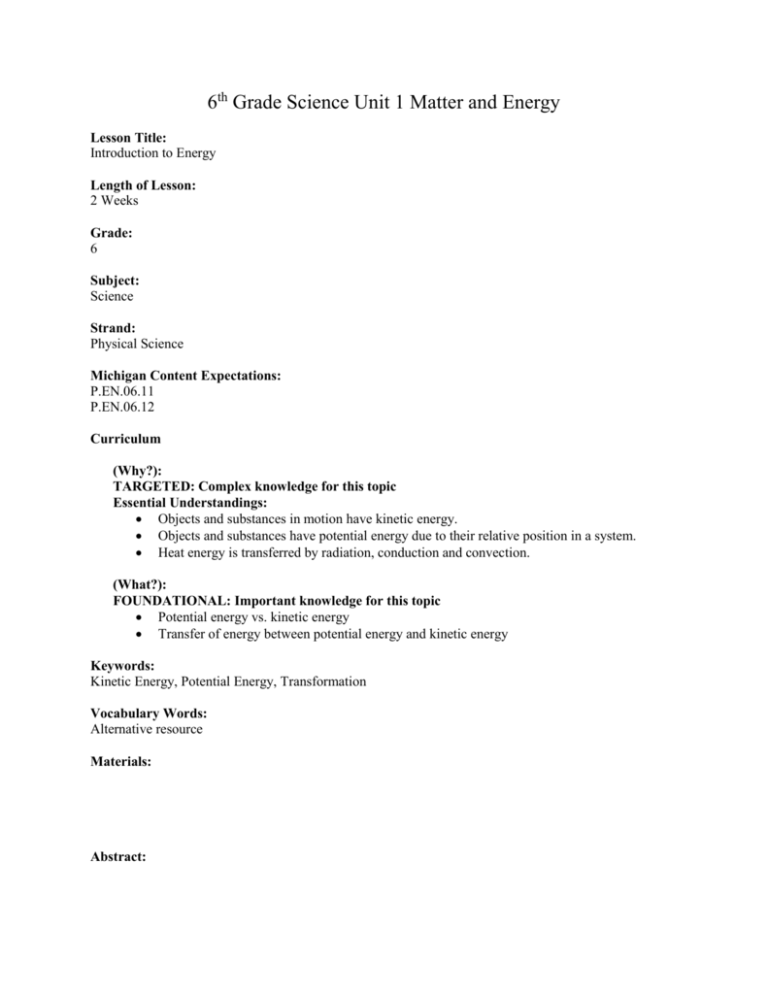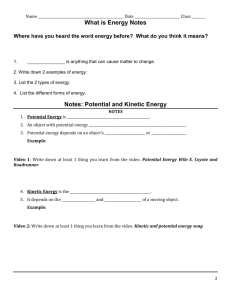File - Port Huron UDL
advertisement

6th Grade Science Unit 1 Matter and Energy Lesson Title: Introduction to Energy Length of Lesson: 2 Weeks Grade: 6 Subject: Science Strand: Physical Science Michigan Content Expectations: P.EN.06.11 P.EN.06.12 Curriculum (Why?): TARGETED: Complex knowledge for this topic Essential Understandings: Objects and substances in motion have kinetic energy. Objects and substances have potential energy due to their relative position in a system. Heat energy is transferred by radiation, conduction and convection. (What?): FOUNDATIONAL: Important knowledge for this topic Potential energy vs. kinetic energy Transfer of energy between potential energy and kinetic energy Keywords: Kinetic Energy, Potential Energy, Transformation Vocabulary Words: Alternative resource Materials: Abstract: The following lesson is part of a larger unit on energy. In this lesson the students will learn the difference between potential and kinetic energy and begin to understand energy transformation. This lesson begins our study of energy. Essential Questions: 1. What is the difference between potential and kinetic energy? 2. What are some everyday situations where potential and kinetic energy are at work? 3. When does transformation between potential and kinetic energy take place in simple mechanical systems? Learning Objectives: Students will be able to: o Express the difference between potential and kinetic energy. o Identify everyday examples of potential and kinetic energy. o Demonstrate an understanding of the transformation between potential and kinetic energy in simple mechanical systems. Summative Assessment: Students will be given a choice between a movie, digital story, poster board, PowerPoint or some other form of expression that demonstrates their knowledge about the energy concepts taught throughout the unit. Explorations: Energy Activities: 1. Explore activity –Glencoe Science: Motion, Forces and Energy p. 125 Analyze a Marble Launch 2. Mini Lab – Glencoe Science: Motion, Forces and Energy p. 133 Analyzing Energy Transformations 3. 4. Roller Coaster Lab from Jason Project http://www.jason.org/ Checks for Understanding: Items turned in after each group or individual project will be used to check student comprehension. The teacher can walk around and monitor student progress throughout the duration of this lesson and answer questions as necessary. Extended Practice: Online Learning: Students can go to the websites listed below to read about and interact with the concepts covered in this lesson. Jason Science Site http://www.eia.doe.gov/kids/energy.cfm?page=about_forms_of_energy-forms Kinetic and Potential Energy Song Energy: Who wants to be a Millionaire? TeacherTube Energy Videos Closing: The student groups will present the form of expression they have chosen that demonstrates their understanding of the concepts covered during this lesson. Resources: Webquests: http://www.glencoe.com/sec/science/lep_science/lep2002/lb/physical/wwwlinksM/index.php?iRef=655& iChapter=5&iUnit=1614&iUnitNumber=3&iArticle=655 Annenberg video on energy: http://www.learner.org/vod/vod_window.html?pid=1708 Glencoe Science: Motion, Forces, and Energy (text) United Streaming Videos http://guest.portaportal.com/science6 Notes: 1 inch pipe insulation and marbles; for roller coaster on wall project Daily Lesson Plan Day 1: Lesson Opening 1. Show a group of pictures displaying kinetic or potential energy in everyday situations (for example: a stretched rubber band, a lit candle, apple, people playing sports, power plants) 2. Elicit student discussion on possible connections between the images. 3. Show the group of pictures again with labels directing attention to the forms of energy. a. UDL Note: Having text on pictures provides for multiple means of engagement. 4. Following the discussion show the video below: http://www.jason.org/gated/Operations/MissionPageContent.aspx?rpid=6298 5. Exit Card: a. Describe how we know energy is present, even though it is not always visible. b. UDL Note: Students should be given multiple ways to demonstrate 6. Day 2: Explanation of labs, activities and technology for Days 3 and 4 Day 3 and 4: Energy Stations Station 1: Explore Activity (Explore activity –Glencoe Science: Motion, Forces and Energy p. 125 Analyze a Marble Launch) 1. Students complete the Explore Activity. 2. Using Wallwisher.com the students post a reply to the following: Describe your experiment and what you discovered. How did the different heights cause the distance to change? 3. Using Wallwisher.com the students post a reply to the following: Describe your experiment and what you discovered. How did the different heights cause the distance to change? Station 2: Mini Lab – Glencoe Science: Motion, Forces and Energy p. 133 Analyzing Energy Transformations 1. Students complete the Mini Lab 2. Analysis (Students will respond to the following via edublogs.com): a. Compare the depths of the craters to determine which ball had the most kinetic energy as it hit the clay. Why did this ball have the most kinetic energy? b. Explain how potential energy was transformed into kinetic energy during your activity. Station 3: Roller Coaster on www.jason.org 1. When completed with the roller coaster the student will video tape their results with narration. Station 4: Research (vocabulary and knowledge building) 1. A list of vocabulary words and concepts are provided to the students during this station. 2. Research options: a. Internet b. Text c. Other (student driven) Day 5: Check for understanding, whole group discussion, and/or demonstrations of the following concepts and vocabulary: Kinetic vs. potential energy Potential and kinetic energy in everyday life Objects and substances in motion have kinetic energy. Objects and substances in a system may have a potential energy due to their relative positions in a system. Demonstrate the transformation between potential and kinetic energy in simple mechanical systems, the following links demonstrate Poetential and Kinetic Energy in Simple Mechanical Systems Images Forms of potential energy Day 6 and 7: Options are provided and presented to students to express what they have learned. Organize groups of students into the kinds of energy identified on the transparency provided in on the link below. Ask each group to think of one new way to use that type of energy in their school or home. http://www.teachervision.fen.com/science/printable/2647.html?detoured=1 Day 8: Student presentations or work completed on days six and seven. (remember to check labs on Jason.org.)




